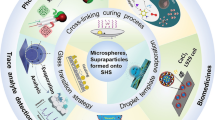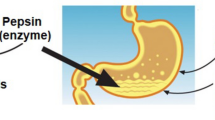Abstract
Novel fluorescent poly(styrene–acrylamide–acrylic acid) nanoparticles (FPSAAN) were synthesized by means of soapless emulsion polymerization and being modified with hydrazine hydrate by hydrazinolysis. The azidocarbonyl groups which can be rapidly coupled with proteins under mild condition were introduced onto the fluorescent nanoparticles by azido-reaction. Bovine serum albumin (BSA) was selected as a model protein to be covalently immobilized on the azidocarbonyl FPSAAN. Atom force microscopy (AFM), Transmission electron microscopy (TEM), Ultraviolet–visible (UV/Vis) spectrometer, Fourier transforms infrared spectrometer (FTIR), nanoparticle size analyzer and fluorescence spectrophotometer were used to characterize the FPSAAN. Results showed that FPSAAN had a regular spherical shape, and a dramatic narrow size distribution (polydispersity index 0.046 ± 0.009). The fluorescence intensity of FPSAAN (λex/λem = 253/306 nm), hydrazide-FPSAAN (λex/λem = 260/326 nm), and protein-immobilized FPSAAN (λex/λem = 258/325 nm) was linearly related to the concentration ranging from 1.0 × 10−3 g l−1 to 10.0 × 10−3 g l−1. The linear relationship was obtained. The equations are y = 52.808x + 16.465 (R 2 = 0.9927), y = 5.1814x + 4.1535 (R 2 = 0.9935) and y = 5.2227x + 5.2883 (R 2 = 0.9937), respectively. In addition, external factors such as pH and ionic strength exert a slight influence on fluorescent properties. The experiments of the immobilization of BSA indicated that FPSAAN with azidocarbonyl groups could be covalently coupled with BSA at the rate of 41.1%. Meanwhile, hCG antibody immobilized FPSAAN have the similar fluorescence characteristics to BSA immobilized FPSAAN. Only negligible difference of the fluorescence characteristics can be found. Furthermore, the fluorescence characteristics of hCG antibody immobilized FPSAAN have not been obviously affected after mixed with the hCG antigen and human plasma. These novel azidocarbonyl FPSAAN with stable fluorescence and active functional azidocarbonyl groups could be used as a promising fluorescent probe for quantitative detection, protein immobilization, cell labeling research and early rapid clinical diagnostics.










Similar content being viewed by others
Abbreviations
- PSAAN:
-
Poly(styrene–acrylamide–acrylic acid) nanoparticles
- FPSAAN:
-
Fluorescent poly(styrene–acrylamide–acrylic acid) nanoparticles
- Hydrazide-FPSAAN:
-
FPSAAN bearing hydrazide groups
- Azidocarbonyl FPSAAN:
-
FPSAAN bearing azidocarbonyl groups
- Protein-immobilized FPSAAN:
-
Azidocarbonyl FPSAAN coupling with BSA
References
M. Tabuchi, M. Ueda, N. Kaji, Y. Yamasaki, Y. Nagasaki, K. Yoshikawa, K. Kataoka, Y. Baba, Nat. Biotechnol. 22, 337–340 (2004). doi:10.1038/nbt939
X.Q. Liu, Y.P. Guang, H.Z. Liu, Z.Y. Ma, Y. Yang, X.B. Wu, J. Magn. Magn. Mater. 293, 111–118 (2005). doi:10.1016/j.jmmm.2005.01.051
Y. Weizmann, F. Patolsky, E. Katz, I. Willner, J. Am. Chem. Soc. 125, 3452–3454 (2003). doi:10.1021/ja028850x
M. Nichkova, D. Dosev, S.J. Gee, B.D. Hammock, I.M. Kennedy, Anal. Chem. 77, 6864–6873 (2005). doi:10.1021/ac050826p
B.N.G. Giepmans, S.R. Adams, M.H. Ellisman, R.Y. Tsien, Science 312, 217–223 (2006). doi:10.1126/science.1124618
Y.R. Duan, Q. Wang, Z.R. Zhang, J. Mater. Sci: Mater. Med. 17, 509–516 (2006). doi:10.1007/s10856-006-8933-3
Z.Q. Wu, S.L. Gong, C. Li, Z. Zhang, W.H. Huang, L.Z. Meng, X.J. Lu, Y.B. He, Eur. Polym. J. 41, 1985–1992 (2005). doi:10.1016/j.eurpolymj.2005.03.021
L. Josephson, M.F. Kircher, U. Mahmood, Y. Tang, R. Weissleder, Bioconjug. Chem. 13, 554–560 (2002). doi:10.1021/bc015555d
H. Ow, D.R. Larson, M. Srivastava, B.A. Baird, W.W. Webb, U. Wiesner, Nano. Lett. 5, 113–117 (2005). doi:10.1021/nl0482478
J.F. Peng, K.M. Wang, W.H. Tan, X.X. He, C.M. He, P. Wu, F. Liu, Talanta 71, 833–840 (2007). doi:10.1016/j.talanta.2006.05.064
J. Choi, Y. Zhao, D. Zhang, S. Chien, Y.H. Lo, Nano. Lett. 3, 995–1000 (2003). doi:10.1021/nl034106e
H.L. Jiang, K.J. Zhu, Biomaterials 23, 2345–2351 (2002). doi:10.1016/S0142-9612(01)00368-4
S.A. Kushon, K.D. Ley, K. Bradford, R.M. Jones, D. McBranch, D. Whitten, Langmuir 18, 7245–7249 (2002). doi:10.1021/la026211u
B.I. Lemon, R.M. Crooks, J. Am. Chem. Soc. 122, 12886–12887 (2000). doi:10.1021/ja0031321
C.S. Yang, C.H. Chang, P.J. Tsai, W.Y. Chen, F.G. Tseng, L.W. Lo, Anal. Chem. 76, 4465–4471 (2004). doi:10.1021/ac035491v
S. Santra, P. Zhang, K. Wang, R. Tapec, W. Tan, Anal. Chem. 73, 4988–4993 (2001). doi:10.1021/ac010406+
C. Wu, C. Szymanski, J. McNeill, Langmuir 22, 2956–2960 (2006). doi:10.1021/la060188l
B. Dubertret, P. Skourides, D.J. Norris, V. Noireaux, A.H. Brivanlou, A. Libchaber, Science 298, 1759–1762 (2002). doi:10.1126/science.1077194
C.R. Goldsmith, J. Jaworski, M. Sheng, S.J.J. Lippard, J. Am. Chem. Soc. 128, 418–419 (2006). doi:10.1021/ja0559754
J.W. Gratama, J.L. D’Hautcourt, F. Mandy, G. Rothe, D. Barnett, G. Janossy, S. Papa, G. Schmitz, R. Lenkei, Cytometry 33, 166–178 (1998). doi:10.1002/(SICI)1097-0320(19981001)33:2<166::AID-CYTO11>3.0.CO;2-S
C. Scholz, M. Iijima, Y. Nagasaki, K. Kataoka, Macromolecules 28, 7295–7297 (1995). doi:10.1021/ma00125a040
S.E. Shim, H. Lee, S. Choe, Macromolecules 37, 5565–5571 (2004). doi:10.1021/ma049930j
W.H. Tan, K.M. Wang, X.X. He, X.J. Zhao, T. Drake, L. Wang, R.P. Bagwe, Med. Res. Rev. 24, 621–638 (2004)
Z.Y. Ma, Y.P. Guan, X.Q. Liu, H.Z. Liu, Polym. Adv. Technol. 16, 554–558 (2005). doi:10.1002/pat.618
Y.C. Liu, G.J. Dong, Y.C. Zhao, J. Immunol. Methods 124, 159–163 (1989). doi:10.1016/0022-1759(89)90348-7
G.P. Wang, E.Q. Song, H.Y. Xie, Z.L. Zhang, Z.Q. Tian, C. Zuo, D.W. Pang, D.C. Wu, Y.B. Shi, Chem. Commun. 34, 4276–4278 (2005)
W. Mehnert, K. Mäder, Adv. Drug Deliv. Rev. 47, 165–196 (2001). doi:10.1016/S0169-409X(01)00105-3
K. Aslan, M. Wu, J.R. Lakowicz, C.D. Geddes, J. Am. Chem. Soc. 129, 1524–1525 (2007). doi:10.1021/ja0680820
J.E. Fuller, G.T. Zugates, L.S. Ferreira, H.S. Ow, N.N. Nguyen, U.B. Wiesner, R.S. Langer, Biomaterials 29, 1526–1532 (2008). doi:10.1016/j.biomaterials.2007.11.025
F. Bertorelle, C. Wilhelm, J. Roger, F. Gazeau, C. Me’nager, V. Cabuil, Langmuir 22, 5385–5391 (2006). doi:10.1021/la052710u
T.M. Blattler, S. Pasche, M. Textor, H.J. Griesser, Langmuir 22, 5760–5769 (2006). doi:10.1021/la0602766
C.D. Hahn, C. Leitner, T. Weinbrenner, R. Schlapak, A. Tinazli, R. Tampe, B. Lackner, C. Steindl, P. Hinterdorfer, H.J. Gruber, M. Holzl, Bioconjug. Chem. 18, 247–253 (2007). doi:10.1021/bc060292e
C.H. Ho, L. Limberis, K.D. Caldwell, R.J. Stewart, Langmuir 14, 3889–3894 (1998). doi:10.1021/la980148k
S. Ko, J. Jang, Biomacromolecules 8, 1400–1403 (2007). doi:10.1021/bm070077g
Acknowledgments
This study has been supported by grants from National Natural Science Foundations of China (Nos. 30772658 and 30570494).
Author information
Authors and Affiliations
Corresponding author
Rights and permissions
About this article
Cite this article
Lu, M., Wu, D. & Guo, N. Novel functionalized ternary copolymer fluorescent nanoparticles: synthesis, fluorescent characteristics and protein immobilization. J Mater Sci: Mater Med 20, 563–572 (2009). https://doi.org/10.1007/s10856-008-3596-x
Received:
Accepted:
Published:
Issue Date:
DOI: https://doi.org/10.1007/s10856-008-3596-x




